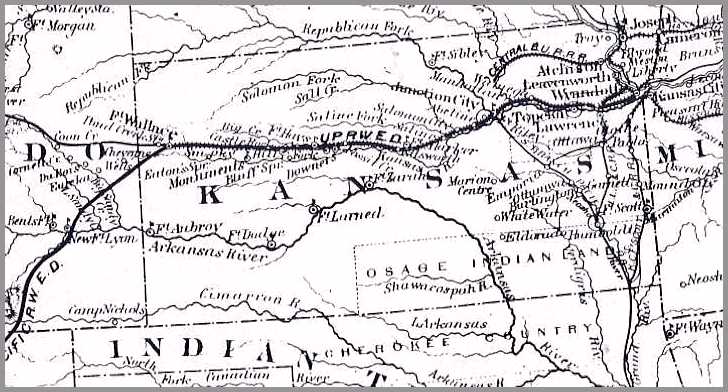
Addendum to: LeConte, J. L., 1868.
Notes on the geology of survey for the extension of the Union Pacific Railway, E. D., from the Smoky Hill River, Kansas, to the Rio Grande.
Review Printing House, Philadelphia, 76 p., with folded map.
 |
Addendum to: LeConte, J. L., 1868. Notes on the geology of survey for the extension of the Union Pacific Railway, E. D., from the Smoky Hill River, Kansas, to the Rio Grande. Review Printing House, Philadelphia, 76 p., with folded map. Copyright © 2002-2009 by Mike EverhartPage last updated 07/12/2009 |
Wherein E. D. Cope describes and names for the first time in print a new, very large plesiosaur from western Kansas. This article was probably published before Cope verbally reported the discovery to the Academy of Natural Sciences of Philadelphia on March 24, 1868.
| 68
________________________ Note on the Fossil Reptiles, near Fort Wallace. Mr. E. D. Cope has kindly furnished me with the following communication upon the collection of fossil bones, made by Dr. Thos. H. Turner, U. S. A., referred to on p.11, which was received at the Academy of Natural Sciences of Philadelphia, while the last pages of this report were passing through the press. The gratitude of men of Science, both here and elsewhere, is due to Dr. Turner for his labors in thus preserving from destruction these valuable relics, and for his liberality in placing them in a museum where they can be so thoroughly studied. In the progress of the road, many similar specimens may be found, and the great interest which attaches to them, should cause every exertion to be made, in order to collect them and place them in proper hands for investigation. "One of the most interesting results of the expedition has been the recovery of some of the largest representatives of the Ancient Marine Fauna of the region traversed by the route. The collection recently received from Dr. Turner, contains remains of two species of Marine Saurians, the larger of some forty feet in length, the other not more than half as large. Both are allied to the Plesiosaurus, the smaller being provisionally referred to the immediate American representative of that genus. The larger approaches genera already known from cretaceous rocks of New Jersey and southern States, called by Leidy Discosaurus and Brimosaurus. A much larger portion of the Kansas Reptile than of these, has however, been discovered, and sufficient to indicate its distinction from them, and that it was one of the largest and most formidable of the group of Saurians to which it belongs. General peculiarities of structure may be indicated as follows: it possesses a tail of great length, which was elevated, compressed and adapted for sculling the ponderous body through the water. The limbs appear to have been disproportionately small. The sternal and pelvic plate-like bones are of great extent, but of little thickness, and indicate large abdominal and thoracic cavities. The dorsal line was no doubt highly ridged or keeled, a fit structure for an aquatic creature. Of the head, unfortunately little is known, and the form of the neck has not yet been determined, as the details of structure are as yet concealed in the matrix. This dragon was named from the singular plates which project from the under surface of many of the vertebrae, Elasmosaurus platyurus Cope. The smaller saurian was represented by the end of the muzzle with the teeth, and perhaps a few vertebrae. It has received the name of Discosaurus carinatus Cope. Some scales of a large Physoclyst or Ctentoid fish were found in the same matrix, which are closely allied, if not identical, with those found by Dr. LeConte, in rocks near Fort Wallace, and whose age he has elsewhere pointed out. A second Ctenoid fish also left remains." |